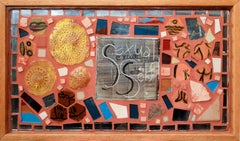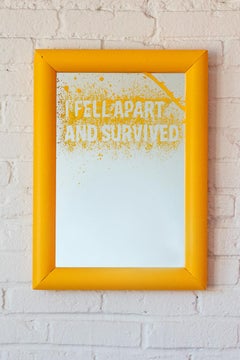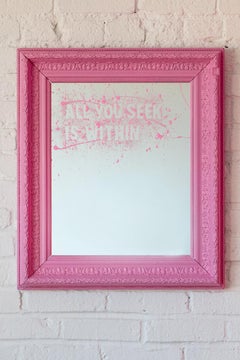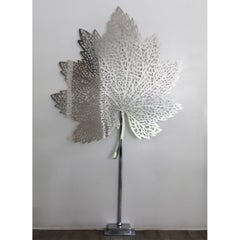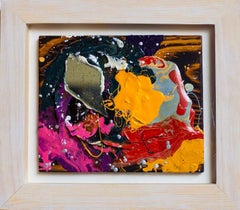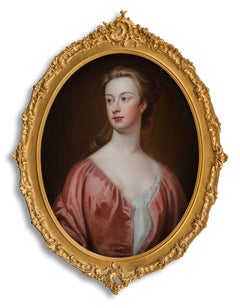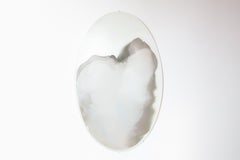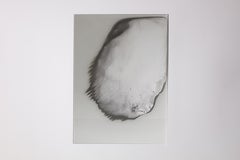Mirror More Art
to
4
4
2
2
1
2
1
1
Overall Height
to
Overall Width
to
7
5
2
7
2
1
1
19,292
1,215
1,150
890
694
Style: Contemporary
Medium: Mirror
"Sexual Self" Woodcut Relief, Mirror and Glass Mosaic
By Isaiah Zagar
Located in Philadelphia, PA
"Sexual Self" is an original mosaic by Isaiah Zagar measuring 17in x 29in. This piece ships in the pictured wooden frame.
Isaiah Zagar is an award-winning mosaic mural artist who...
Category
21st Century and Contemporary Contemporary Mirror More Art
Materials
Clay, Woodcut, Mirror, Mixed Media, Mosaic
"Coalescence #2" 21" x 16" inch by Oleg Char
Located in Culver City, CA
"Coalescence #2" 21" x 16" inch by Oleg Char
Medium: Spray paint, Acrylic on restored Antique Mirror, Wood frame
THE ARTIST:
Unearth the es...
Category
21st Century and Contemporary Contemporary Mirror More Art
Materials
Mirror, Wood, Spray Paint, Acrylic
"Coalescence #1" 25" x 21.5" inch by Oleg Char
Located in Culver City, CA
"Coalescence #1" 25" x 21.5" inch by Oleg Char
Medium: Spray paint, Acrylic on restored Antique Mirror, Wood frame
THE ARTIST:
Unearth the ...
Category
21st Century and Contemporary Contemporary Mirror More Art
Materials
Mirror, Wood, Spray Paint, Acrylic
Maple Leaf. Handmade Modern Chrome Sculpture.
Located in Mexico City, MX
This art piece was carefully made, traced, cut and polished till reflections started to appear. The stainless steel, imported from Italy was carefully cut for avoiding burned edges. ...
Category
2010s Contemporary Mirror More Art
Materials
Metal, Brass, Stainless Steel
Serie: Mujeres con espejo 5
By Ray Smith
Located in Cuernavaca, Morelos
Mixed technique
Category
2010s Contemporary Mirror More Art
Materials
Mirror, Wood, Paint
Serie: Abstractos con espejo 8
By Ray Smith
Located in Cuernavaca, Morelos
Mixed technique
Category
2010s Contemporary Mirror More Art
Materials
Mirror, Wood, Paint
3 to 5 Seconds Mirror
Located in New York, NY
Jenny Nordberg (b. 1978, Sweden) is an industrial designer based in the south of Sweden whose interdisciplinary work explores and challenges contemporary ideas of design as well as t...
Category
2010s Contemporary Mirror More Art
Materials
Silver
Related Items
Portrait of an Elegant Lady in a Red Silk Dress, Beautiful Antique Frame c.1720
By Jonathan Richardson the Elder
Located in London, GB
This beautiful portrait was painted circa 1725 and is a fine example of the English eighteenth century portrait style. The artist has chosen to depict the lady against a plain background wearing a simple red silk dress and transparent headdress hanging down the back. The sitter is not shown with jewellery or any other elements to distract the viewer’s attached, thus highlighting the beauty of the young sitter. This restrained manner achieves a sense of understated elegance.
The portrait genre was valued particularly highly in English society. Neither landscapes nor allegorical pictures were ever priced so highly at exhibitions and in the trade as depictions of people, from the highest aristocracy to scholars, writers, poets and statesmen. With the rich colouring and lyrical characterisation, these works are representative of the archetypal English portrait and is are very appealing examples of British portraiture...
Category
18th Century Old Masters Mirror More Art
Materials
Canvas, Oil
H 37.41 in W 28.94 in D 1.97 in
Portrait of a Lady in Silver Silk Dress & Pearls c.1660, Oil on canvas painting
Located in London, GB
This exquisite work is an accomplished example of the type of portrait in vogue in England during the third quarter of the 17th century. There was a large demand for paintings in England and the demand for portraits was greatest. Many artists worked in this lucrative field, even artists who initially trained in the more respected field of history painting, such as Peter Lely, turned their attention to portraiture to meet this demand. Moreover, it was not uncommon for the British, even for men, to present a gift of one’s portrait to a friend - portraits were first and foremost a memento.
Woman at court often vied with one another in displays of rich and fashionable clothing. The drapery was either painted from the customer’s own clothes or was perhaps a creation using fabrics loosely tacked together in the studio. This was a common practice of Lely and his studio props included swathes of fabric and pieces of cloth. The sitter’s sumptuous attire and gauze scarf, fastened by a large diamond brooch, is of the finest material and is representative of wealth. Pearls were an obligatory accompaniment since at least the 1630s and they are worn in abundance – in her hair, on her attire, as a necklace, and as pear-shaped earrings called unions d’excellence, reflecting the difficulty of finding perfectly matched pearls of such large size. They could range up to 20 millimetres in diameter. Her hairstyle help date the painting to the early 1660’s.
Peter Lely, the son of a Dutch...
Category
17th Century Old Masters Mirror More Art
Materials
Canvas, Oil
H 36.62 in W 30.71 in D 1.97 in
Portrait Gentleman Black Coat Orange Sash, Dutch Old Master, Oil on Panel c.1650
By Bartholomeus van der Helst
Located in London, GB
This exquisite portrait of a gentleman depicted in a sumptuous black coat edged with silver and slashed sleeves is an excellent example of the type of portrait fashionable in England and the Low Countries during the 17th century. The confident pose, striking orange sash - the colour of the house of Orange Nassau - and the leather gorget imbue the sitter with a sense of masculinity and power. The profusely decorated costume is of the highest quality and de rigueur of an elite class - the artist has carefully cultivated this portrait to emphasise the sitter’s wealth and standing in the society that he belonged to. The casual pose, with one arm resting on a hip, is much less formal than earlier decades, and it speaks of ‘sprezzatura’ – one’s appearance should not appear laborious, but instead, effortless.
The oil on cradled panel portrait can be dated to circa 1650 based on the hairstyle and the attire - small falling collar, short doublet (doublets reduced in size to just below the ribcage in the late 1650’s), and the type of slashed sleeves with the sleeve seams left open to reveal the white fabric.
The demand for portraits in the Netherlands was great in the 17th century. Bartholemeus van der Helst was considered to be one of the leading portrait painters of the Dutch Golden Age surpassing even Rembrandt as the most sought-after portraitist in Harlaam. The Dutch Golden Age, roughly spanning the 17th century, was a period when Dutch trade, science, military, and art were among the most acclaimed in the world. Dutch explorers charted new territory and settled abroad. Trade by the Dutch East-India Company thrived, and war heroes from the naval battles were decorated and became national heroes. During this time, The Dutch Old Masters began to prevail in the art world, creating a depth of realistic portraits of people and life in the area that has hardly been surpassed. The Golden Age painters depicted the scenes that their discerning new middle-class patrons wanted to see. This new wealth from merchant activities and exploration combined with a lack of church patronage, shifted art subjects away from biblical genres. Still life’s of items of everyday objects, landscapes, and seascapes reflecting the naval and trade power that the Republic enjoyed were popular. The new wealthy class were keen to have their portraits commissioned and many artists worked in this lucrative field. Such was the popularity of art that everyone had a painting, even the humble butcher, and hundreds of thousands of paintings were produced.
By tradition the sitter is Maarten Tromp (1598-1653) who was an Admiral in the Dutch Navy (the reverse of the portrait contains an old handwritten inscription “van Tromp”). Certainly, the distinctive orange sash is similar to those worn by officers of the Dutch army in the Netherlands who served under the Princes of Orange and the House of Nassau. However, it should be noted that the physiognomy differs from other images of Tromp.
Tromp was the oldest son of Harpert Maertensz, a naval officer and captain. He joined the Dutch navy as a lieutenant in July 1622 and was later promoted from captain to Lieutenant-Admiral of Holland and West Frisia in 1637. In 1639, during the Dutch struggle for independence from Spain, Tromp defeated a large Spanish fleet bound for Flanders at the Battle of the Downs, which marked an enormous change - the end of Spanish naval power. He was killed in action during the First Anglo-Dutch War in 1653 where he commanded the Dutch fleet in the battle of Scheveningen.
Gloves were an absolutely vital accessory and the elaborate pair in this portrait are embellished with threads of silk and precious metals and salmon-coloured lining. He wears only one glove and holds the other, providing an opportunity to better display the cuffs and detail on his right wrist and forearm. The gloves are probably made from the most prized leather which came from Spain, in particular from Cordova. Cordovan leather was tanned with a special vegetal process that left it both highly impermeable and divinely soft. King Charles I, posed in a rather relaxed manner for Daniel Mytens’s portrait in 1631, is wearing gloves and boots in matching Cordovan leather. The hide is thick, but you can see just how supple it is from the way the gauntlet dimples and the long boot legs fold over themselves, rippling and wrinkling at the ankles.
Apart from keeping hands warm the use of gloves during the 15th through the 19th centuries were full of symbolism and they were worn regardless of the season. They kept the skin unblemished - soft, smooth hands were considered highly attractive. This combination of necessity and proximity to bare skin made gloves a deeply personal gift and they took on a strong symbolic significance and were regarded as emblematic of fidelity and loyalty for hundreds of years. Such was the importance of their symbolism was that some gloves were never intended to be worn at all. Their luxury made them ideal gifts at court, and so in the 15th and 16th centuries, ambassadors often presented them as symbols of loyalty.
Until the mid-19th century, it was customary to give gloves as tokens to guests at weddings and to mourners at funerals. Gentleman often gifted their bride-to-be with a pair of gloves (the obligatory gift) and were handed over at the betrothal and put on display before the wedding took place. It was probably their direct contact with the skin that led to the eroticism of gloves. Not only were pairs often exchanged between lovers, but from the 16th to the 18th centuries, it was common practice to remove one glove and give it as a gift to a favourite. The idea of the item being presented still warm from the wearer’s hand is certainly suggestive. Following the death of King George IV, his executors purportedly found over a thousand mismatched ladies’ gloves among his possessions.
The sentiment of a 17th-century poem reveals the popularity of the practice: “Come to our wedding to requite your loves / Shew us your hands and we’ll fit you with gloves.” Such generosity might be pricey for the hosts, but gloves of varying quality could be offered depending on the status of the recipient. Pairs made with the finest Spanish leather might be reserved for immediate family, while coarse sheep’s leather could be distributed among the servants and tradesmen. The apportioning of quality according to class provided a very clear message of the gloves’ intended use. For refined guests, they were decoration; for the lower classes, they were functional.
Bartholomeus van der Helst...
Category
17th Century Old Masters Mirror More Art
Materials
Oil, Wood Panel
H 38.59 in W 31.89 in D 2.76 in
Portrait of a Lady in a Blue & Pink Silk Dress, possibly Mrs Rowe, Signed Dated
Located in London, GB
This charming picture, which has been signed and dated: H. Pickering pinxt 1752 is a type favoured by the highly successful artist Henry Pickering. Pickering’s painting life, from 1...
Category
18th Century Old Masters Mirror More Art
Materials
Oil, Canvas
Henry PickeringPortrait of a Lady in a Blue & Pink Silk Dress, possibly Mrs Rowe, Signed Dated, 1752
H 39.38 in W 34.65 in D 2.76 in
Portrait Painting of Lady Mary Capel, Countess of Essex in a Yellow Dress c.1698
Located in London, GB
This portrait depicts an elegant, aristocratic women wearing a yellow silk dress with white chemise and a red mantle elegantly draped around her body. By tradition the portrait represents Mary Capel, Countess of Essex. Born Lady Mary Bentinck in 1679, she was the daughter of William Bentinck, 1st Earl of Portland, a Dutch and English nobleman who became in an early stage the favourite of stadtholder William, Prince of Orange (the future King of England) and his wife Anne Villiers (died 1688).
Lady Mary's maternal grandparents were Sir Edward Villiers and Lady Frances Howard...
Category
17th Century Old Masters Mirror More Art
Materials
Canvas, Oil
H 37.41 in W 32.29 in D 2.76 in
Portrait of a Young Gentleman and Pet Dog c.1680, Antique oil on Canvas Painting
Located in London, GB
The portrait genre was valued particularly highly in English society. Neither landscapes nor allegorical pictures were ever priced so highly at exhibitions and in the trade as depictions of people, from the highest aristocracy to scholars, writers, poets and statesmen. This charming portrait, presented by Titan Fine Art, of a fashionable young gentleman and his faithful pet is an excellent example of 17th century child portraiture in England. There is a remarkable beauty and sensitivity to the portrait. The face, particularly well rendered, has captured the character of this young man – both charming and at the same time mischievous.
Only the playful attention of a small dog suggests anything less than patrician dignity. Symbolism was important in portraiture and it provided a pointed and aspirational narrative that would not have been lost on contemporary viewers. For example, the presence of the dog, which was likely the boy’s pet, is at once a charming pictorial device and also a clear allusion to fidelity, trust and loyalty.
The hairstyle and the attire, notably the type of cravat with the blue ribbon, help to date this portrait to between 1670 to 1685. Until the late eighteenth century children were dressed as adults - boys were dressed like men in breeches, vests, and coats between four and seven years of age. The expensive lace is an indication to his family’s wealth.
Held in a good quality and condition antique gilded frame.
Born in Suffolk, Mary Beale, nee Cradock (1633-1699) was employed by many of the most distinguished persons of her time including nobility, landed gentry, and clergymen. Technically accomplished, her paintings are noteworthy for their honest and sympathetic portrayal. In 1651 she married Charles Beale...
Category
17th Century Old Masters Mirror More Art
Materials
Canvas, Oil
H 35.44 in W 32.29 in D 3.15 in
Portrait of a Lady, Katherine St Aubyn, Godolphin, Cornelius Johnson, Oil canvas
By Cornelius Johnson
Located in London, GB
Titan Fine Art are pleased to present this charming bust-length portrait, which is a good example of the style of portrait painted in England in the second quarter of the seventeenth century. The attire consists of the finest silks, and the full billowing sleeves, bows, and hairstyle help in dating this portrait to circa 1637. The accessory par excellence – pearls – are worn as a necklace and were a very popular accessory. The artist makes no attempt to obey the rules of Baroque and instead sensitively depicts in complete honesty his sitter against a plain wall, and without distracting backdrops and flowing draperies – this work is very redolent of the sumptuous half-length female portraits that Cornelius Johnson...
Category
17th Century Old Masters Mirror More Art
Materials
Canvas, Cotton Canvas, Oil
H 32.29 in W 27.96 in D 1.58 in
Portrait Lady in Red Silk Dress c.1710, Michael Dahl, oil on canvas painting
By (Circle of) Michael Dahl
Located in London, GB
This charming work is a good example of the type of portrait in vogue during the first quarter of the eighteenth century in Britain. The sitter, portrayed bust-length, wears a russet silk dress over a white chemise...
Category
18th Century Old Masters Mirror More Art
Materials
Canvas, Oil
H 33.27 in W 28.35 in D 1.97 in
Portrait of Lady, Grace Saunderson, Viscountess Castleton Oil on canvas Painting
Located in London, GB
Portrait of Grace Saunderson, Viscountess Castleton (1635-1667) c.1665-67
Sir Peter Lely and Studio (1618-1680)
Titan Fine Art present this work, which formed part of a collection of family pictures and heirlooms of the Saunderson, Viscount Castleton family and their descendants, the Earls of Scarbrough, at their magnificent family seat Sandbeck Park, where the Earls still reside today almost four hundred years later. It was painted in the studio of Sir Peter Lely...
Category
17th Century Old Masters Mirror More Art
Materials
Canvas, Oil
H 35.04 in W 31.11 in D 1.97 in
MJ: THE ULTIMATE KING OF POP (Swarovski Skull+CustomBase+Crown+Glove Replica)
Located in LOS ANGELES, CA
**ANNUAL SUPER SALE UNTIL JUNE 15TH ONLY**
*This Price Won't Be Repeated Again This Year-Take Advantage Of It*
***Looking for one of kind precious high ending gift tha...
Category
21st Century and Contemporary Contemporary Mirror More Art
Materials
Metal
No Reserve
H 13 in W 16 in D 16 in
Portrait of an Elegant Lady in a Blue Silk Dress, Beautiful Antique Frame c.1720
By Jonathan Richardson the Elder
Located in London, GB
This beautiful portrait was painted circa 1725 and is a fine example of the English eighteenth century portrait style. The artist has chosen to depict the lady in a simple blue silk dress and without jewelry or a background, thus allowing the viewer to concentrate solely on the beauty of the sitter. The effect of this restrained manner creates a sense of understated elegance.
The portrait genre was valued particularly highly in English society. Neither landscapes nor allegorical pictures were ever priced so highly at exhibitions and in the trade as depictions of people, from the highest aristocracy to scholars, writers, poets and statesmen. With the rich colouring and lyrical characterisation, these works are representative of the archetypal English portrait and is are very appealing examples of British portraiture...
Category
18th Century Old Masters Mirror More Art
Materials
Canvas, Oil
H 37.41 in W 28.94 in D 2.37 in
Portrait of a Lady, Maria Virginia Borghese Chigi Princess Farnese Oil on canvas
Located in London, GB
This exquisite portrait, presented by Titan Fine Art, belongs to a type of portrait known as ‘Les Belle Romanes’; Voet is perhaps best remembered for his series of them – a great set of portraits...
Category
17th Century Old Masters Mirror More Art
Materials
Canvas, Oil
Previously Available Items
3 to 5 Seconds Mirror
Located in New York, NY
Jenny Nordberg (b. 1978, Sweden) is an industrial designer based in the south of Sweden whose interdisciplinary work explores and challenges contemporary ideas of design as well as t...
Category
2010s Contemporary Mirror More Art
Materials
Silver
3 to 5 Seconds Mirror
Located in New York, NY
Jenny Nordberg (b. 1978, Sweden) is an industrial designer based in the south of Sweden whose interdisciplinary work explores and challenges contemporary ideas of design as well as t...
Category
2010s Contemporary Mirror More Art
Materials
Silver
3 to 5 Seconds Mirror
Located in New York, NY
Jenny Nordberg (b. 1978, Sweden) is an industrial designer based in the south of Sweden whose interdisciplinary work explores and challenges contemporary ideas of design as well as t...
Category
2010s Contemporary Mirror More Art
Materials
Silver
3 to 5 Seconds Mirror
Located in New York, NY
Jenny Nordberg (b. 1978, Sweden) is an industrial designer based in the south of Sweden whose interdisciplinary work explores and challenges contemporary ideas of design as well as t...
Category
2010s Contemporary Mirror More Art
Materials
Silver
Serie: Abstractos con espejo 2
By Ray Smith
Located in Cuernavaca, Morelos
Mixed technique
Category
2010s Contemporary Mirror More Art
Materials
Mirror, Wood, Paint
Mirror more art for sale on 1stDibs.
Find a wide variety of authentic Mirror more art available on 1stDibs. While artists have worked in this medium across a range of time periods, art made with this material during the 21st Century is especially popular. If you’re looking to add more art created with this material to introduce a provocative pop of color and texture to an otherwise neutral space in your home, the works available on 1stDibs include elements of orange and other colors. There are many well-known artists whose body of work includes ceramic sculptures. Popular artists on 1stDibs associated with pieces like this include and Isaiah Zagar. Frequently made by artists working in the Contemporary, all of these pieces for sale are unique and many will draw the attention of guests in your home. Not every interior allows for large Mirror more art, so small editions measuring 0.1 inches across are also available Prices for more art made by famous or emerging artists can differ depending on medium, time period and other attributes. On 1stDibs, the price for these items starts at $120 and tops out at $167,108, while the average work can sell for $1,403.
Recently Viewed
View AllMore Ways To Browse
Painting On Wood D Birds
Roman Historical Paintings
American Indian Figure
Barbara Taylor
Jacob 17th
Large Sculpture Totem
Virgin And Child Painting
Warhol Mother
18th C French Painting
Life Size Saint Sculptures
Magazine Covers 1930s
Order Of St John
Servant Paintings
Urban Garden Print
Man Pin
19th Century Cow Paintings
5 Figures Bronze Sculpture
India Horse Sculpture
